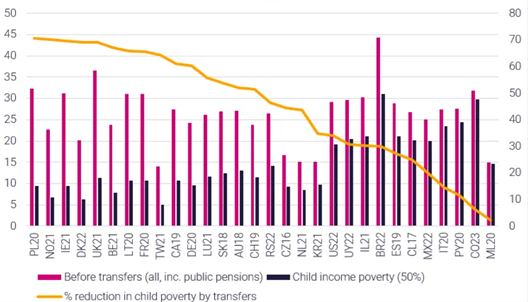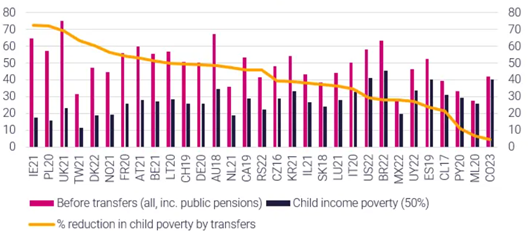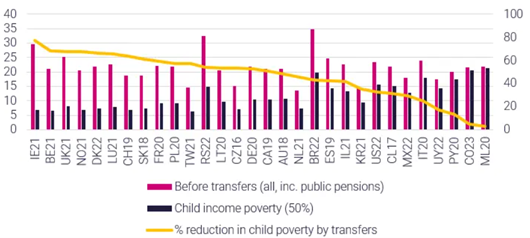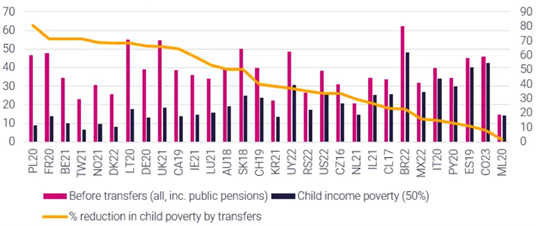Issue, No.34 (June 2025)
Comparing Child Poverty Using the Luxembourg Income Study and Policy Recommendations
Introduction
Child poverty represents one of the most serious and persistent social challenges worldwide. It affects children’s cognitive, educational, health, and social development, and can perpetuate cycles of economic and social inequality across generations. To understand the extent of the issue and enable cross-country comparisons, this analysis utilizes the most recent data from the Luxembourg Income Study (LIS) to examine child poverty in different national contexts. Various poverty scenarios will be presented, based on household composition, and evidence-based policy recommendations will be proposed.
State of Child Poverty
There is considerable variation in child poverty rates across the following countries. As illustrated in Figure 1, Northern European economies such as Denmark, Norway, and Finland report very low rates (around 5-7%), whereas countries like the United States and Spain exhibit substantially higher rates (around 20%). At the higher end of the spectrum, countries such as Colombia and Brazil reach child poverty rates of approximately 30%. These disparities are not solely a reflection of income levels, but rather differences in redistributive policies and the extent of social spending. Countries with more comprehensive welfare systems are generally more effective in reducing child poverty. This is clearly evident in the graph, which shows that countries with similar levels of pre-transfer child poverty can end up with very different outcomes after public transfers are taken into account.
Figure 1: Overall child poverty rates
(% of children in households with equivalent income less than 50% median)

Note: Countries are ordered left to right by the percentage reduction in child poverty achieved by social transfers.
Source: Author’s calculations of LIS data, 2024.
As illustrated in Figures 2, 3 and 4, single-parent households and large families – defined as those with three or more children – face significantly higher poverty risks compared to smaller or two-parent families, highlighting the vulnerability associated with limited income sources and greater financial demands. This trend is consistent across various national contexts and underscores the importance of supporting these vulnerable groups and reduce the structural inequalities they face.
Figure 2: Child poverty rates for single parent families
(% of children in households with equivalent income less than 50% median)

Note: Countries are ordered left to right by the percentage reduction in child poverty achieved by social transfers.
Source: Author’s calculations of LIS data, 2024.
Figure 3: Child poverty rates in one child families
(% of children in households with equivalent income less than 50% median)

Note: Countries are ordered left to right by the percentage reduction in child poverty achieved by social transfers.
Source: Author’s calculations of LIS data, 2024.
Figure 4: Child poverty rates for three plus child
(% of children in households with equivalent income less than 50% median)

Note: Countries are ordered left to right by the percentage reduction in child poverty achieved by social transfers.
Source: Author’s calculations of LIS data, 2024.
Conclusions
The data from the Luxembourg Income Study clearly demonstrate that child poverty is not an inevitable outcome, but rather a political choice. At a time when the need for strong, inclusive social policy is greater than ever, it is essential to recognize the urgency of implementing comprehensive and universal policies that support children throughout their development.
Just as most societies maintain a generational pact to ensure financial security for the elderly through pension systems, a similar commitment must be made to the well-being of children. Unlike older adults, children are entirely dependent on others for their survival, growth, and future potential. They need intentional support through well-designed public policies that not only alleviate immediate hardship but also lay the foundation for long-term development. Countries that prioritize investments in children – through transfers, services, and social protection – can achieve substantial reductions in child poverty and future economic returns. However, as the data suggest, the volume of social spending alone is not sufficient. Many countries with high levels of social expenditure experience only modest returns in terms of poverty reduction, particularly when compared to others with similar spending levels. This highlights the need to reassess not just the scale, but also the structure and focus of spending.
Research shows that the most effective strategies are those that are both comprehensive and universal – covering every stage of childhood, from the prenatal period through to age 18. These policies must be available to all children, regardless of household income or social status. Decades of evidence have shown that targeted policies, while well-intentioned, often fail to reduce inequality in a meaningful or lasting way. Rather than lifting families above the poverty threshold, such approaches often merely reshuffle the income distribution, offering minimal long-term impact.
Universal policies, by contrast, ensure broad support and have the potential to drive real change. Key components of the proposed policy portfolio should include universal maternity and paternity leave, universal childcare, and a universal child benefit. These measures would not only promote equity and social cohesion, but also invest in the long-term development and well-being of future generations.
References
| Richardson, D., D. Harris, J. R. Hudson, Mackinder S. (2023). Too Little, Too Late: An Assessment of Public Spending on Children by Age in 84 Countries. Innocenti Research Brief. Florence: UNICEF Office of Research – Innocenti. |
| ILO, UNICEF, and Learning for Well Being Institute. (2024). The Promise of Universal Child Benefits: The Foundational Policy for Economic and Social Development. ILO Brief. Geneva: International Labour Organization. |
